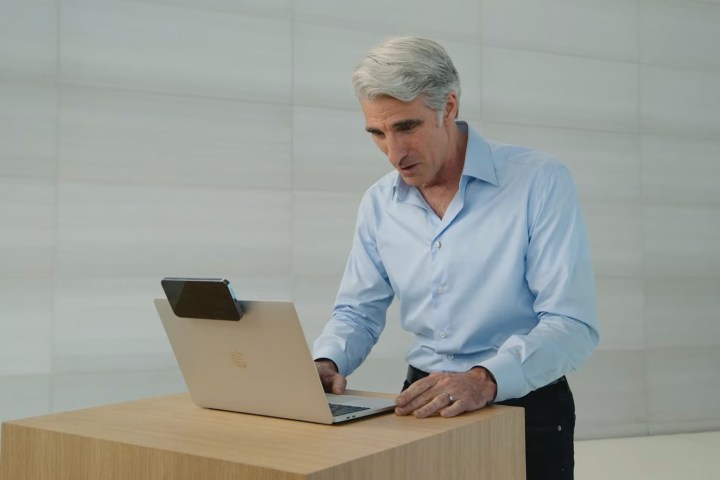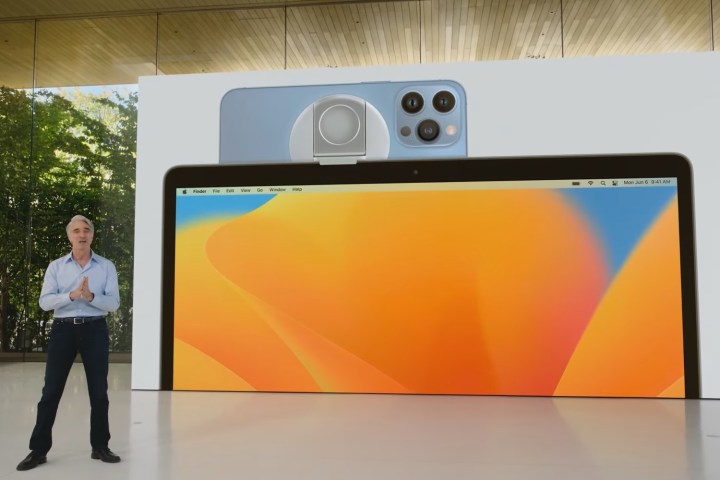
Apple has turned the iPhone into a webcam for the Mac, officially. You’ll now look sharp in video calls with centered focus wizardry, and even some bokeh magic thrown into the mix. If you’re an Android phone loyalist, you’re stuck using your pricey MacBook’s not-so-good webcam. It’s a stop-gap solution and a sign that Mac webcams aren’t getting the same “revolutionary” upgrades as the silicon inside those machines.
One can argue that there is only so much space to fit snazzy camera hardware beneath the thin lid of a MacBook. But the problem is not exclusive to Apple’s laptops. The Mac Studio external display, armed with a 12-megapixel camera and will burn a $1,600-sized hole in your wallet, also garnered less-than-stellar reviews for its webcam performance.

Apple eventually rolled out a software update to fix the iMac’s camera quality woes, but that’s not a good spectacle. Apple’s latest webcam solution involving an iPhone is an interesting idea with some fascinating use cases. But even so, it feels like an odd workaround rather than a permanent solution.
Apple’s solution works
The ability to use an iPhone as a high-resolution webcam for the Mac isn’t novel. There are already apps that allow the same for both Windows PC and Mac. The Reincubate Camo is one app I’ve used most frequently, even though the USB plug-in requirement made me wish the whole system was wireless. Apple has done just that in 2022.
You mount your iPhone atop a Mac, launch the FaceTime desktop app, and you’re good to go. No complex fiddling with wireless connectivity or system settings is required. In fact, the whole iPhone-as-your-Mac-webcam thing also works with third-party clients such as Microsoft Teams, Webex, and Zoom. Interestingly, a mention of Google Meet was missing from Apple’s WWDC presentation.
There are some neat complementary tricks, aside from just crystal clear visuals. When using an iPhone as a webcam, the Center Stage tech kicks into action. It follows the subject’s movement and automatically adjusts the frame to keep them at the center. Users can apply a background blur effect to stand out (or hide their cheesy background with superhero figurines) and enable the studio lighting effect that illuminates their face while darkening the background to make them stand out.
Be gone, distractions

Another highlight is something called “desktop view.” Desktop view appears to leverage an iPhone’s ultrawide camera to show the action on your desk in a split-screen view concurrently. It’s a neat convenience, especially for folks conducting online training sessions that give a view of what’s happening on the desk. You no longer need a pricey DSLR camera contraption to enjoy sharp visuals and a wide field of view in video calls. As long as you have an iPhone, of course.
Standout features, but only if you have an iPhone
A Mac is not exactly an affordable computing machine, but you need an iPhone to take advantage of Apple’s latest video calling innovation. Unsurprisingly, an iPhone is not exactly an affordable smartphone, either. Unless you’re deeply invested in the allure of the “Apple ecosystem,” you’ll need to get an iPhone to impress your fellow video call participants with crystal clear visuals, subject tracking, and portrait lighting tricks.

Some third-party video calling apps already offer the latter two. Still, these webcam-driven solutions can’t match the quality delivered by an iPhone’s superior imaging hardware and image processing algorithms.
Your aging iPhone isn’t going to cut it, chief
The newer your iPhone, the better are the visuals. Apple’s Continuity Camera features require an iPhone (with a not-ancient camera) running iOS 12 or higher and MacOS Mojave or a later build. Just make sure that you’re hooked to a decent Wi-Fi network because all those crystal clear video signals need some fat bandwidth to make you shine in your iPhone-powered video calls.
Also, don’t forget to buy one of those hideous mounts that Apple’s Craig Federighi demoed at Apple’s developer conference. Belkin will be selling one of those accessories, but it’s only going to arrive later this year. You’ll also have to wait for Apple to release MacOS Ventura, which isn’t going to happen until the fall season.
Until then, stick with the terrible 720p webcam on your MacBook, or the not-too-improved 1080p camera if you forked serious cash on the 14-inch or 16-inch MacBook Pro.
Just give me a better webcam already!
If you have an older Mac lying on your desk — say a 2015 MacBook with its poor keyboard, a single port, and shoddy webcam — you can partially excuse Apple for cramming a 720p webcam on it. But here’s the infuriating part. Apple just launched a MacBook Pro refresh with the M2 chip. It has the same design as the MacBook Pro with the “revolutionary” Touch Bar that arrived in 2016. And yet, it starts at $1,299 and still rocks a 720p FaceTime HD camera.

That translates to about 0.9-megapixels worth of sensor resolution. Not surprisingly, the 1080p webcam on the new M2 MacBook Air barely crosses the 2-megapixel point. Oddly, even the $429 iPhone SE (2022) has jumped to a 7-megapixel front camera. For all its camera expertise that does wonders on the iPhones, it’s a shame that Apple’s Mac portfolio continues to serve poor imaging hardware and visual quality.
Turning the iPhone into a webcam, just so you can get better visuals in your FaceTime calls, is not a solution for a lousy webcam on a $1,299 machine. Had the price of a MacBook been a tad lower, there wouldn’t be any qualms forking out cash on a fancy add-on such as the 4K Lumina webcam that goes for $199 (or any other good-quality webcam out there).
So, here’s the message that Apple really wanted to send home at WWDC. Need killer video call visuals on your Mac because the webcam sucks? Get an iPhone. Plus, an accessory. And oh, welcome to the Apple ecosystem, human!



